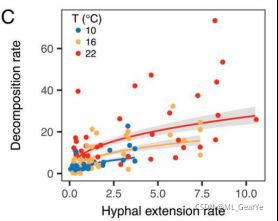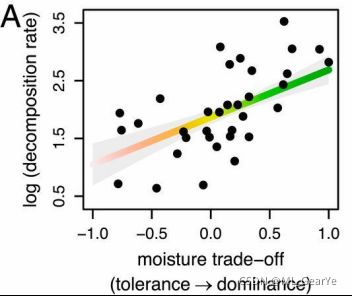2021数学建模美赛A题 题目解读
2021数学建模美赛A题 题目解读
原文翻译:基于特征的真菌分解木材的理解_ML_GearYe的博客-CSDN博客
原题文档:Fungi Problem
Problem A: Fungi
The carbon cycle describes the process of the exchange of carbon throughout the geochemical cycle of the Earth, and is a vital component for life on the planet. Part of the carbon cycle includes the decomposition of compounds, allowing carbon to be renewed and used in other forms. One key component of this part of the process is the decomposition of plant material and woody fibers.
碳循环描述了整个地球地球化学循环中碳的交换过程,是地球上生命的重要组成部分。碳循环的一部分包括化合物的分解,使碳得以更新并以其他形式使用。这部分过程的一个关键组成部分是植物材料和木质纤维的分解。
Some of the key agents in decomposing woody fibers are fungi. The authors of a recent research article on wood decomposition by fungi identified fungi traits that determine decomposition rates and also noted links between certain traits[1]. In particular, the slow growing strains of fungi tend to be better able to survive and grow in the presence of environmental changes with respect to moisture and temperature, while the faster growing strains tend to be less robust to the same changes. A synopsis of this article can be found below on page 3.
分解木质纤维的一些关键因素是真菌。最近一篇关于真菌对木材分解的研究文章的作者确定了决定分解率的真菌特征,并指出了某些特征之间的联系[1]。特别是,生长缓慢的真菌菌株在湿度和温度等环境变化的情况下往往能够更好地生存和生长,而生长较快的菌株往往对相同的变化不那么健壮。这篇文章的概要可以在下面的第 3 页找到。
These researchers examined a large number of traits associated with different fungi and their role in the decomposition of ground litter (dead plant material) and woody fibers. For this MCM Problem you should focus on just two traits of a fungus: the growth rate of the fungus and the fungus’ tolerance to moisture. Your primary goal is to model the decomposition of woody fibers in a given patch of land, and do so in the presence of multiple types of fungi breaking down woody fibers in the same area.
这些研究人员检查了与不同真菌相关的大量特征及其在地面凋落物(死植物材料)和木质纤维分解中的作用。对于这个 MCM 问题,您应该只关注真菌的两个特征:真菌的生长速度和真菌对水分的耐受性。您的主要目标是模拟给定土地中木本纤维的分解过程,并在同一地区存在多种分解木本纤维的真菌的情况下进行建模。
As you explore the relationship of the two traits of interest, growth rate and moisture tolerance, with the rate of decomposition, several questions may arise to include: Using these two traits, how do the different fungi interact and decompose ground litter in a fixed patch of land in different environments? Within these different environments, how will the decomposition be impacted over time as conditions vary? How do environmental changes and the variation in environmental change impact the long-term dynamics with respect to decomposition, as well as competition between fungi in a given environment? The estimation for the decomposition rates, given the growth rate, is shown in Figure 1. The estimation of the decomposition rates, given the relative moisture tolerance, is shown in Figure 2.
当您探索感兴趣的两个特征(生长速度和耐湿性)与分解速度之间的关系时,可能会出现几个问题,包括: 使用这两个特征,不同的真菌如何相互作用并分解固定斑块中的地面垃圾不同环境下的土地?在这些不同的环境中,随着时间的推移,分解将如何随着条件的变化而受到影响?环境变化和环境变化的变化如何影响分解的长期动态以及特定环境中真菌之间的竞争?在给定生长速率的情况下,对分解速率的估计如图 1 所示。在给定相对湿度耐受性的情况下,对分解速率的估计如图 2 所示。
Figure 1: The relationship between the hyphal extension
rate (mm/day) of various fungi and the resulting wood decomposition rate (% mass loss over 122 days) at
various temperatures. (Figure 1C in [1]).
图1:菌丝延伸的关系
不同温度下各种真菌的分解率(毫米/天)和由此产生的木材分解率(122 天的质量损失百分比)。([1] 中的图 1C)。
Figure 2: The relationship between the moisture tolerance
(difference of each isolate’s competitive ranking and their moisture niche width, both scaled to [0,1]) of various fungi and the resulting wood decomposition rate (% mass loss over 122 days, log transformed). (Figure 4A in [1]).
图2:耐湿性的关系
(每个分离株的竞争等级和它们的水分生态位宽度的差异,均缩放到 [0,1])各种真菌和由此产生的木材分解率(122 天的质量损失百分比,对数转换)。 ([1] 中的图 4A)。
Requirement: Your paper should explore and address the following aspects.
要求:你的论文应该探索和解决以下几个方面。
· Build a mathematical model that describes the breakdown of ground litter and woody fibers through fungal activity in the presence of multiple species of fungi.
· In your model, incorporate the interactions between different species of fungi, which have different growth rates and different moisture tolerances as shown in Figures 1 and 2.
· Provide an analysis of the model and describe the interactions between the different types of fungi. The dynamics of the interactions should be characterized and described including both short- and long-term trends. Your analysis should examine the sensitivity to rapid fluctuations in the environment, and you should determine the overall impact of changing atmospheric trends to assess the impact of variation of local weather patterns.
· Include predictions about the relative advantages and disadvantages for each species and combinations of species likely to persist, and do so for different environments including arid, semi-arid, temperate, arboreal, and tropical rain forests.
· Describe how the diversity of fungal communities of a system impacts the overall efficiency of a system with respect to the breakdown of ground litter. Predict the importance and role of biodiversity in the presence of different degrees of variability in the local environment.
· 建立一个数学模型,描述在多种真菌存在的情况下,地面垃圾和木质纤维通过真菌活动的分解。
· 在您的模型中,加入不同种类真菌之间的相互作用,它们具有不同的生长速度和不同的耐湿性,如图 1 和图 2 所示。
· 提供模型分析并描述不同类型真菌之间的相互作用。应表征和描述相互作用的动态,包括短期和长期趋势。您的分析应检查对环境快速波动的敏感性,并应确定大气趋势变化的总体影响,以评估当地天气模式变化的影响。
· 包括对可能持续存在的每个物种和物种组合的相对优势和劣势的预测,并针对干旱、半干旱、温带、树栖和热带雨林等不同环境进行预测。
· 描述系统真菌群落的多样性如何影响系统在地面垃圾分解方面的整体效率。在当地环境存在不同程度的变化时,预测生物多样性的重要性和作用。
Include a two-page article of your results. Your article should be appropriate for inclusion in an introductory college level biology textbook to discuss recent developments in our understanding of the roles fungi play in ecological systems.
包括一篇关于你的结果的两页文章。您的文章应该适合包含在介绍性大学级生物学教科书中,以讨论我们对真菌在生态系统中所起作用的理解的最新进展。
Your PDF solution of no more than 25 total pages should include:
· One-page Summary Sheet.
· Table of Contents.
· Your complete solution.
· Two-page Article.
· References list.
总页数不超过 25 页的 PDF 解决方案应包括:
· 一页汇总表。
· 目录。
· 您的完整解决方案。
· 两页文章。
· 参考文献列表。
Note: The MCM Contest now has a 25 page limit. All aspects of your submission count toward the 25 page limit (Summary Sheet, Table of Contents, Reference List and any Appendices).
Reference:
- Nicky Lustenhouwer, Daniel S. Maynard, Mark A. Bradford, Daniel L. Lindner, Brad Oberle, Amy E. Zanne, and Thomas W. Crowther, "A trait-based understanding of wood decomposition by fungi," Proceedings of the National Academy of Sciences of the United States, May 13, 2020.
注意:MCM 竞赛现在有 25 页的限制。您提交的所有方面都计入 25 页限制(摘要表、目录、参考列表和任何附录)。
参考:
- Nicky Lustenhouwer、Daniel S. Maynard、Mark A. Bradford、Daniel L. Lindner、Brad Oberle、Amy E. Zanne 和 Thomas W. Crowther,“基于特性的真菌分解木材”,Proceedings of美国国家科学院,2020 年 5 月 13 日。
原文翻译:基于特征的真菌分解木材的理解_ML_GearYe的博客-CSDN博客
原题文档:Fungi Problem
Research Article Synopsis
We provide a brief synopsis below of the research article by Lustenhouwer, et al [1]. The original full article is available at . Note that you do not need to read the original article to complete this MCM Problem.
The decomposition of organic material is a critical component of the carbon cycle. Large scale modeling of the carbon cycle as well as global climate models are becoming more refined and are incorporating more small scale details. One important detail is the rate associated with the decay of organic material by microbial and fungal communities. The focus of the paper is the different decay rates associated with different types of fungi.
The authors of the paper explored several different traits of fungi to determine the effects of the decomposition of wood. They did so by measuring how much mass was lost in wood blocks after introducing different types of fungi into the blocks. The researchers examined a large number of different traits associated with each fungus and attempted to determine the role these traits play in the decomposition of the wood blocks.
For example, one important trait is the hyphal extension rate. The hyphae are the cells that branch out and form the filaments and structure of a fungus, and the different kind of hyphae play different roles in the life cycle of a fungus. The hyphal extension rate is essentially the growth rate of a fungus. Another trait examined was the density of the hyphae in a given volume.
These two traits are associated with a number of properties of a fungus. For example, it was found that if the hyphal extension rate was larger (faster growth), the fungus was more likely to decompose wood faster. Likewise, if the filaments were denser it was more likely that the decomposition of wood was slower. Additionally, these two traits are also associated with how a fungus reacts to different environmental conditions.
In particular the researchers found that fungi that were better able to adapt to a more varied range of moisture conditions tended to also decompose wood slower. Fungi that grew faster and out-competed other fungi tended to decompose wood faster. Figures 1 and 2 in the MCM Problem A statement show these relationships.
Woody materials break down through multiple stages, and the fungi that were examined in the research article are most relevant with respect to the decay of woody materials in the middle of their decay cycle. The results may differ for other stages of decay. For the purpose of this modeling exercise, you can focus on the results for the middle stage and assume it is consistent for other stages of decomposition. Another consideration is that local environmental conditions can vary greatly over an area and impact the overall dynamics as well.
研究文章概要
我们在下面提供了 Lustenhouwer 等人 [1] 的研究文章的简要概要。原文全文可在 获得。请注意,您无需阅读原始文章即可完成此 MCM 问题。
有机物质的分解是碳循环的关键组成部分。碳循环的大规模建模以及全球气候模型正变得越来越精细,并且正在纳入更多的小规模细节。一个重要的细节是微生物和真菌群落对有机材料的腐烂率。该论文的重点是与不同类型真菌相关的不同腐烂率。
该论文的作者探索了真菌的几种不同特征,以确定木材分解的影响。他们通过测量将不同类型的真菌引入木块后木块中损失了多少质量来做到这一点。研究人员检查了与每种真菌相关的大量不同特征,并试图确定这些特征在木块分解中所起的作用。
例如,一个重要的特征是菌丝延伸率。菌丝是分支出来并形成真菌丝状结构的细胞,不同种类的菌丝在真菌的生命周期中扮演着不同的角色。菌丝延伸率本质上是真菌的生长速度。检查的另一个特征是给定体积中菌丝的密度。
这两个特征与真菌的许多特性有关。例如,发现菌丝延伸率越大(生长越快),真菌越容易分解木材。同样,如果细丝更密集,则木材分解更慢的可能性更大。此外,这两个特征还与真菌对不同环境条件的反应有关。
特别是研究人员发现,能够更好地适应更多样化的水分条件的真菌也往往更慢地分解木材。生长得更快并在竞争中胜过其他真菌的真菌往往更快地分解木材。 MCM 问题 A 陈述中的图 1 和图 2 显示了这些关系。
木质材料经过多个阶段分解,研究文章中检查的真菌与木质材料在其腐烂周期中间的腐烂最为相关。其他衰减阶段的结果可能不同。出于此建模练习的目的,您可以关注中间阶段的结果,并假设它与分解的其他阶段一致。另一个考虑是当地环境条件在一个区域内变化很大,也会影响整体动态。
Glossary:
Biodiversity: Broadly, the variety of life in the world. On a smaller scale, the variety of life in a particular habitat or ecosystem.
Carbon Cycle: The continuous process (or series of processes) by which carbon is exchanged between organisms and the environment, and then reused throughout the planet.
Competitive Ranking: A measure of the ability for a fungus to out-compete other fungi in a series of pair wise tests in similar conditions.
Earth’s Biosphere: The lithosphere (crust and upper mantle of the earth), the hydrosphere (all of the water on the earth’s surface), and the atmosphere (the envelope of gases surrounding the earth) of the earth.
Fungus (plural: fungi): Any member of the group of eukaryotic (cells that have a nucleus enclosed within a nuclear envelope) organisms. Examples are yeasts, molds, and mushrooms.
Geochemical Cycle: The various pathways and steps by which elements are exchanged through and between the Earth’s biosphere.
Hyphae: The cells that form the filaments within a fungal community.
Hyphal Extension Rate: The rate of growth of a fungus.
Moisture Niche Width: The difference between the maximum and minimum moisture levels in which half of a fungal community can maintain its fastest growth rate.
Moisture Tolerance: The difference between a fungus’ competitive ranking and its moisture niche width.
词汇表:
生物多样性:广义上,世界上生命的多样性。在较小的范围内,特定栖息地或生态系统中的生命多样性。
碳循环:碳在生物体和环境之间进行交换,然后在整个地球上重复使用的连续过程(或一系列过程)。
竞争排名:衡量一种真菌在类似条件下的一系列成对测试中胜过其他真菌的能力。
地球生物圈:地球的岩石圈(地球的地壳和上地幔)、水圈(地球表面的所有水)和大气层(地球周围的气体包层)。
真菌(复数:真菌):真核生物(细胞核包裹在核膜内)的任何成员。例如酵母、霉菌和蘑菇。
地球化学循环:元素通过地球生物圈和在地球生物圈之间交换的各种途径和步骤。
菌丝:在真菌群落中形成细丝的细胞。
菌丝延伸率:真菌的生长速度。
水分位宽:最大和最小水分水平之间的差异,其中一半的真菌群落可以保持其最快的生长速度。
水分耐受性:真菌的竞争排名与其水分生态位宽度之间的差异。

